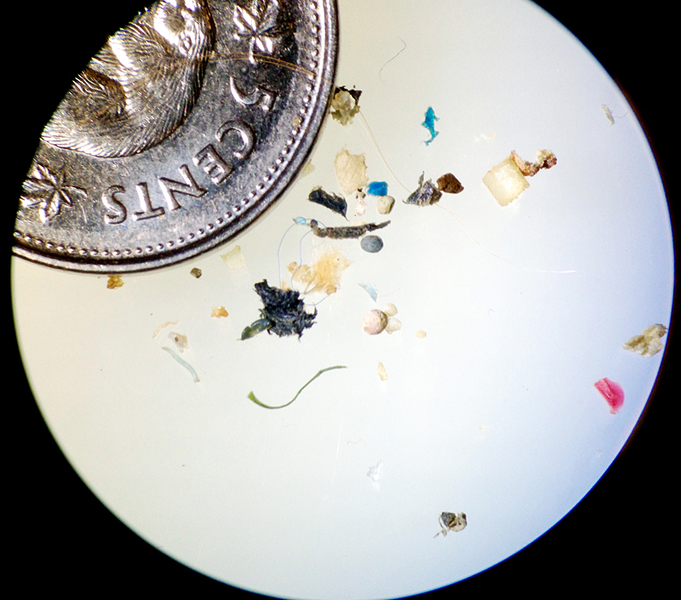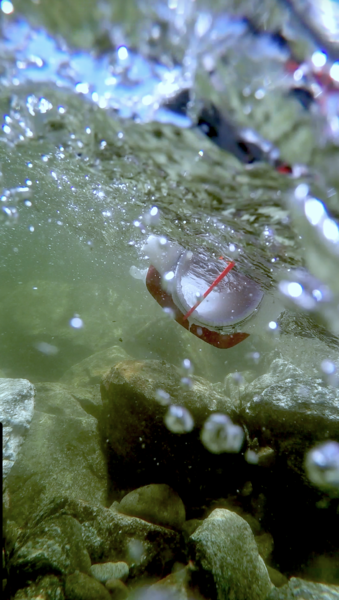**BabyLegs is an aquatic trawl (net system) for monitoring microplastic pollution and biological composition of surface water. ** This tool is comprised of a floatation device attached to a set of childrens tights - hence the name BabyLegs. To collect a sample, first you dip your BabyLegs into a waterway, then drag the device along the water’s surface. The fine-knit mesh of the tights traps microscopic bits of biological materials as well as nurdles and other plastics found within the water. These samples can be processed, identified, counted, and analyzed in order to examine what’s in your waterway. ## Microplastics Of the 5.25 trillion pieces of marine plastics in the world’s oceans, 92% are microplastics less that 5mm in size (Eirksen et al 2014), allowing them to be easily ingested by marine life as small as plankton (Cole et al 2013). Scientists are concerned that because plastics absorb up to a million times more chemicals than surrounding waters (Mato et al 2001), widespread ingestion means that toxicants that accumulate in animals can magnify up food webs, causing a potential threat to human health (Rochman et al 2013, Teuten et al 2009). This makes microplastics an environmental justice issue as people who eat marine mammals or who depend upon fish for sustenance are more likely to carry high toxic burdens. (text [from civiclaboratory.nl](https://civiclaboratory.nl/2015/05/31/babylegs/)) [](/i/25546) The image above shows some of the microplastics BabyLegs captured in the Hudson River, New York City. ## Activities [notes:grid:activity:babylegs] ## Questions Q: Can I change materials on the trawl, or change the design? A: Of course! The only thing you have to make sure of is that the mouth of the trawl is always half in the water and half out. It cannot dive or skip over the water. Also beware of any materials that might put more plastic into the ocean or into the sample (plastic 3D printing, fleece, and plastic thread are particularly bad for this). Also, the design outlined here has been tested in a variety of waters. New designs might not behave as well in choppy water, at higher speeds, or in wind. Q: What sort of data does a sample from BabyLegs yield? A: Things you can know from a sample: * The types of plastics (fragments, films, beads, threads, etc) that are in a body of water. * The relative frequency of each type of plastic compared to others (perhaps you have a lot of fishing gear, but not many microbeads compared to other places) * The relative hotspots for plastics if you do sample strategically in different areas. * Whether there are more or fewer plastics after rainfall events if you trawl before and immediately after rainfalls. This can include other temporal events that you think are adding plastics to your water (storms, tourist festivals, seasons). You will not know: * Where the plastics come from. They might be local, or they might have come from far away. * How long plastics have been in the water. Some things can get tossed around in strong waves and look beat up after short periods of time, while plastics that sink can look pristine after years. * About plastics that are smaller than 1mm. You might be able to see some, but research has shown that 1mm is the smallest cut off size that human eyes can reliably identify a plastic. Q: Has BabyLegs been validated? A. Yes and no. BabyLegs has been validated in laboratory settings to ensure that water flows freely through the device and does not "choke" on water. It is also how we determined that 5 knots is the maximum speed. However, BabyLegs has not been validated against another trawl to ensure she collects samples identical to scientific standards like the manta trawl. Stay tuned-- we should have it done by the end of fall 2018. [Click here for more questions about BabyLegs.](https://publiclab.org/tag/question:babylegs) [](/i/41025?s=o) This image shows BabyLegs in action. You can see that part of the trawl is underwater and some is above water, allowing the trawl to capture things floating on the surface. ...
| Author | Comment | Last activity | Moderation | ||
|---|---|---|---|---|---|
| eustatic | "<3 this is beautiful, thank you for posting. " | Read more » | over 3 years ago | |||
| healfitshop | "Perfect Thank you. :) " | Read more » | almost 4 years ago | |||
| amocorro | "@purl love love love that header photo! What an experience. I added some additional tags to your post as well " | Read more » | almost 4 years ago | |||
| a1ahna | "This is great, Purl! I just heard there was a nurdle spill in Algiers Point, across the river from downtown New Orleans. If you're excited to find..." | Read more » | almost 4 years ago | |||
| pfubochka | "Wow that's sounds really helpful. But sometimes issue cannot be solved so easily. We should find other ways in our community here at forextime " | Read more » | about 4 years ago | |||
| eustatic | "Also, not a total surprise you caught fish, since this is a low-rent Bongo net. People catch shrimp with those, and in University, we used them to..." | Read more » | about 4 years ago | |||
| eustatic | "T'Jomb? Petit Jambes? Jambes de Bebe? " | Read more » | about 4 years ago | |||
| amocorro | "I want to read more urban environmental monitoring adventures from @mimiss! Love all the photos. " | Read more » | about 4 years ago | |||
| stevie | "Hi All! Reminder the call is tonight! Looking forward to speaking with you then. " | Read more » | over 4 years ago | |||
| eustatic | "Yo. I am doing Nurdle Patrol in Louisiana, and trying to coordinate with LSU. This is a particular kind of plastic pollution that is directly dep..." | Read more » | over 4 years ago | |||
| eustatic | "Yo. I am doing Nurdle Patrol in Louisiana, and trying to coordinate with LSU. This is a particular kind of plastic pollution that is directly dep..." | Read more » | over 4 years ago | |||
| kazar | "Hi all -- looking forward to Thursday. Our team was planning to follow the methods for analyzing microplastics in marine & sediment environment..." | Read more » | over 4 years ago | |||
| amocorro | "Hi Everyone! I am always interested in expanding my knowledge base around microplastics, looking forward to joining this call. " | Read more » | over 4 years ago | |||
| stevie | "Hi all! Reminder this call is this Thursday. Looking forward to it! " | Read more » | over 4 years ago | |||
| liz | "Agree, and will mention that the BabyLegs technologists have identified that 3d printed plastic trawls have a higher risk of leaving bits of plasti..." | Read more » | over 4 years ago | |||
| stevie | "Great question! My first thought would be no, you shouldn't be loosing plastic pieces from the bottle into the waterway, but let's chat about this ..." | Read more » | over 4 years ago | |||
| Grace_Schwartz | "I'm interested in deploying Baby Legs as a part of a chemistry lab this Fall. I'm curious--do any contamination issues arise from using a cut plast..." | Read more » | over 4 years ago | |||
| jerdasmeltzer | "Yes! Very interested! Brief history: I was a scientist (hydrogeology and geochemistry with a background in marine ecology and microbiology) for 1..." | Read more » | over 4 years ago | |||
| Zomerstopulis | "They produce about 2,400 tractors a year which is available in red or blue color. All technical data, specifications, price and other information c..." | Read more » | over 4 years ago | |||
| kazar | "Super interested and the timing couldn't be better! I'm a citizen working with the Lower Susquehanna Riverkeeper and we got funding to pioneer (as ..." | Read more » | over 4 years ago | |||
| jibe-b | "@jibe-b awards a barnstar to maxliboiron for their awesome contribution! " | Read more » | over 4 years ago | |||
| maxliboiron | "Hi Stevie, We usually deploy for half an hour. Anything less than that and its not much of a representative sample. That's in relatively steady flo..." | Read more » | over 4 years ago | |||
| maxliboiron | "Here are two videos with live builds FYI: https://www.youtube.com/watch?v=lLVQYbdeC1Q https://www.facebook.com/watch/?v=547320069347987 " | Read more » | over 4 years ago | |||
| jbreen | "Here’s a link to the chapter on determining sample size in an ecological study from Charles Krebs’ Ecological Methodologies textbook: https://www.z..." | Read more » | almost 5 years ago |